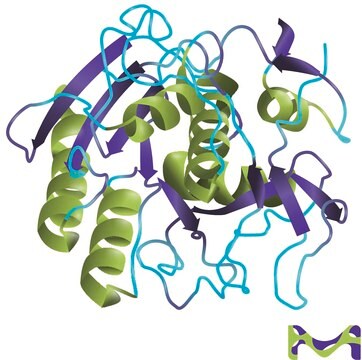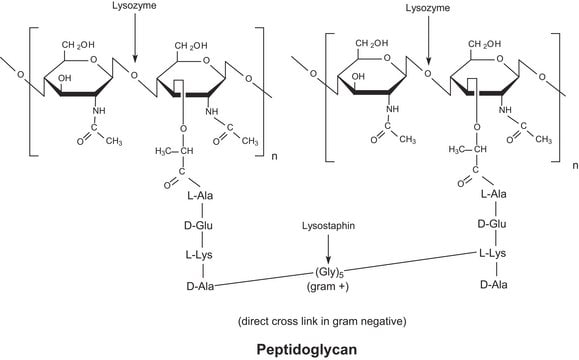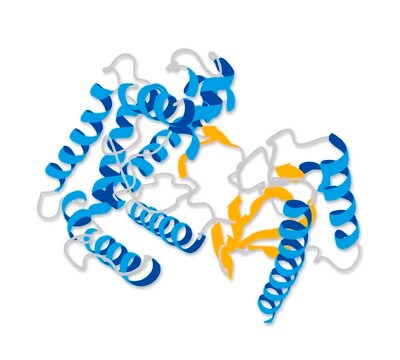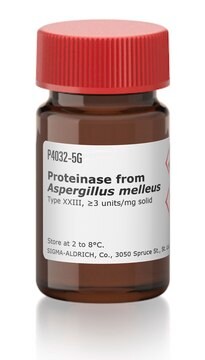P5568
Proteinasi K
≥500 units/mL, buffered aqueous glycerol solution
Sinonimo/i:
Endopeptidasi K
About This Item
Prodotti consigliati
Origine biologica
microbial (T.album
T. ALBUM)
Livello qualitativo
Stato
buffered aqueous glycerol solution
PM
28.93 kDa
Concentrazione
≥10 mg/mL
≥500 units/mL
tecniche
DNA extraction: suitable
Temperatura di conservazione
2-8°C
Cerchi prodotti simili? Visita Guida al confronto tra prodotti
Descrizione generale
Applicazioni
Rimuove le endotossine che si legano alle proteine cationiche come lisozima e ribonucleasi A.
Segnalato come utile per l′isolamento dei mitocondri epatici, di lievito e di fagiolo mungo
Determinazione della localizzazione degli enzimi sulle membrane
Trattamento di sezioni di tessuto incluse in paraffina per esporre i siti di legame dell′antigene per la marcatura dell′anticorpo.
Digestione delle proteine da campioni di tessuto cerebrale per la ricerca sui prioni nell′encefalopatia spongiforme trasmissibile (EST).
- to break down cardiac muscle during histopathology studies
- during the digestion of HEK-293 cells
Azioni biochim/fisiol
Definizione di unità
Stato fisico
Nota sulla preparazione
Avvertenze
Danger
Indicazioni di pericolo
Consigli di prudenza
Classi di pericolo
Resp. Sens. 1
Codice della classe di stoccaggio
10 - Combustible liquids
Classe di pericolosità dell'acqua (WGK)
WGK 1
Punto d’infiammabilità (°F)
Not applicable
Punto d’infiammabilità (°C)
Not applicable
Dispositivi di protezione individuale
Eyeshields, Faceshields, Gloves, type ABEK (EN14387) respirator filter
Scegli una delle versioni più recenti:
Possiedi già questo prodotto?
I documenti relativi ai prodotti acquistati recentemente sono disponibili nell’Archivio dei documenti.
I clienti hanno visto anche
Articoli
Proteinase K (EC 3.4.21.64) activity can be measured spectrophotometrically using hemoglobin as the substrate. Proteinase K hydrolyzes hemoglobin denatured with urea, and liberates Folin-postive amino acids and peptides. One unit will hydrolyze hemoglobin to produce color equivalent to 1.0 μmol of tyrosine per minute at pH 7.5 at 37 °C (color by Folin & Ciocalteu's Phenol Reagent).
Proteinase K (EC 3.4.21.64) activity can be measured spectrophotometrically using hemoglobin as the substrate. Proteinase K hydrolyzes hemoglobin denatured with urea, and liberates Folin-postive amino acids and peptides. One unit will hydrolyze hemoglobin to produce color equivalent to 1.0 μmol of tyrosine per minute at pH 7.5 at 37 °C (color by Folin & Ciocalteu's Phenol Reagent).
Protocolli
Proteinase K (EC 3.4.21.64) activity can be measured spectrophotometrically using hemoglobin as the substrate. Proteinase K hydrolyzes hemoglobin denatured with urea, and liberates Folin-postive amino acids and peptides. One unit will hydrolyze hemoglobin to produce color equivalent to 1.0 μmol of tyrosine per minute at pH 7.5 at 37 °C (color by Folin & Ciocalteu's Phenol Reagent).
Il team dei nostri ricercatori vanta grande esperienza in tutte le aree della ricerca quali Life Science, scienza dei materiali, sintesi chimica, cromatografia, discipline analitiche, ecc..
Contatta l'Assistenza Tecnica.








